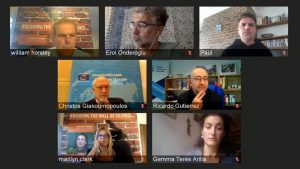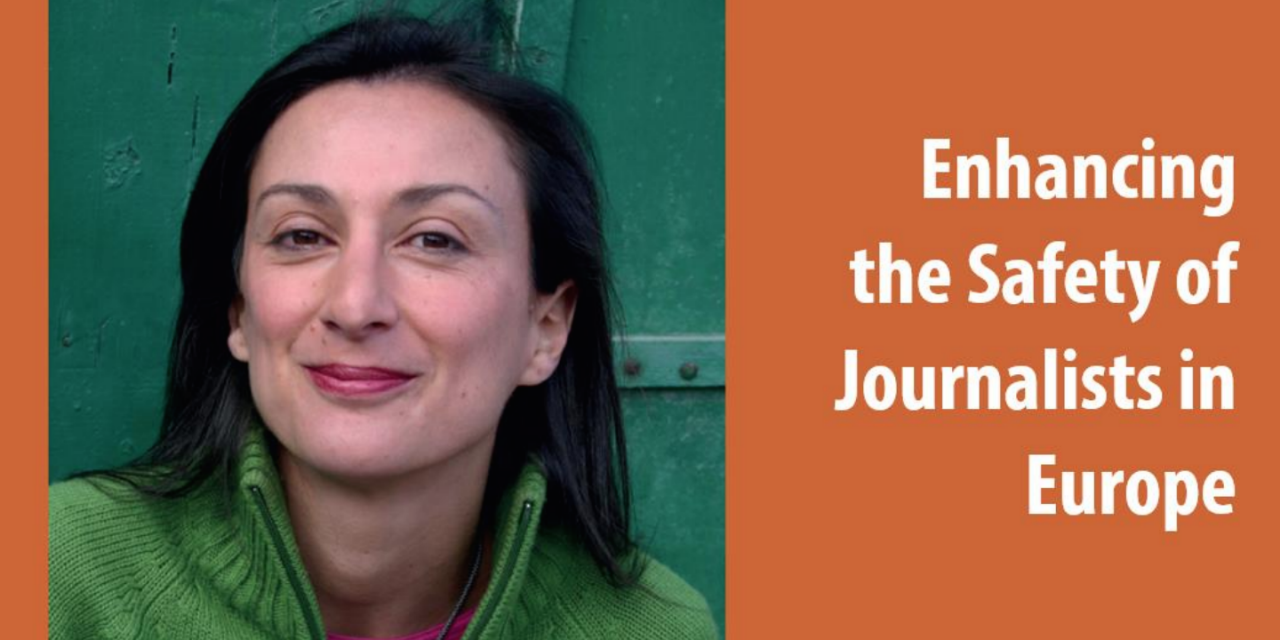Centre for Freedom of the Media (CFOM) international director William Horsley writes on the findings and recommendations for future action in A Mission to inform: Journalists at risk speak out. The book, co-authored by William Horsley and Dr Marilyn Clark, associate professor of psychology at the University of Malta, was published by the Council of Europe this week. The publication was timed to mark the third anniversary of the assassination of the prominent Maltese investigative journalist Daphne Caruana Galizia, who died in a remote-controlled car bomb explosion on 16 October 2017.
The core message from the interviews with twenty “journalists at risk” from countries in every region of Europe is the need for resolute and sustained actions to close the gap between pledges and real implementation of states’ obligations to protect the safety of journalists.
I will look closely at seven major narratives or scenarios of intimidation and barriers which the journalists described. Their first-hand insights have enabled the authors to make informed recommendations for decisive actions by governments, international organisations, journalists and all who are concerned for press freedom in the countries of the Council of Europe. If acted on these can help to transform the current alarming situation for the better.

Council of Europe event held on 14 October to mark the publication of “A Mission to inform: Journalists at risk speak out”.
Above all the journalists want support in order to close the ‘implementation gap’ between the world-class ideals and standards that come from the European Convention and the case law of the European Court of Human Rights, and the obvious lack of effective protections in many European states.
Five years ago, in 2015, Council of Europe governments took a big step forward when they agreed to a world first. They set up, in cooperation with leading journalists’ organisations and NGOs, the Platform for the protection of journalism and the safety of journalists. It is a Europe-wide online alert system to track and follow up with member states on individual threats to media freedom across Europe. More than 800 alerts have now been recorded to create a new dialogue directly with the governments concerned.
And the 2016 Council of Europe Ministerial Recommendation on journalists safety and protection of journalism is a unique practical manual, approved by all governments and having the force of ‘soft law’, on the actions required in order to fulfil their obligations. Especially in terms of the physical protection of journalists under threat and the prosecution and punishment of attacks on media workers. Yet the most striking concern of these journalists at risk is that in their view political leaders and European institutions have so far failed to show the necessary determination to make sure that those high standards are enforced.
NARRATIVE 1): ATTACKS AND INTIMIDATION
Violence and threats create a climate of fear, as Daphne Caruana Galizia herself said in the interview she gave just ten days before she was assassinated. Many others saw her under constant attack and they were scared. When that happens the vital watchdog role of journalists is stifled, and a wider chilling effect is felt in the society where those attacks and killings take place.
State authorities have an obligation under international law to provide effective measures of protection, as happens in Italy with some journalists who face death threats for reporting on the mafia. Lives have also been saved by journalists going into hiding or to safety abroad. But the right response is systematic respect for the rule of law, with democratic controls and oversight of all areas of politics and public life, and a free voice for the media and civil society.
NARRATIVE 2) SMEARS SCAPEGOATING AND DEMONISATION
Investigative journalist Kostas Vaxevanis in Greece spoke of being the target of “character assassination” to criminalise and discredit his work. Many others have been called traitors, enemies of the people and other insults.
Such language used by public figures creates a climate of incitement to violence and hate, making journalism an ever more dangerous profession. Critical journalists have increasingly been publicly vilified and discredited, as well as harassed and attacked. When this happens elected politicians must always condemn it, in public.
Vicious trolling and threats of sexual violence against women journalists must be deterred by strong penalties, and interventions by the tech companies whose networks carry such messages.
NARRATIVE 3: JUDICIAL HARASSMENT AND MISUSE OF LAW
A Mission to inform: Journalists at risk speak out seeks to do just what today’s event is advertised as being about – that is, breaking the wall of silence about injustice, abuses of power and assaults on free and independent journalism.
Many Strasbourg court rulings have shown that national laws on defamation, terrorism and national security have been used in ways that violate the European Convention. Journalists protest that in some parts of Europe it has become commonplace for state authorities to bring false and vexatious charges against journalists and other critics to silence them, and all too often to send them to jail or stop them from working for years at a time.
Police and prosecutors have often shown scorn for the golden rule of press freedom, the right to keep the confidentiality of journalists’ sources, by making police searches or intercepting journalists’ online traffic, in attempts to criminalise both journalists and whistle-blowers.
The correct response to any judicial or political harassment of journalists is written clearly in the 2016 Guidelines that were agreed by the governments themselves: to establish and act on the findings of regular independent reviews of national laws AND practices that protect the right to freedom of expression and other fundamental rights.
The outcome of those reviews must be to amend or if necessary repeal the legislation that fails to safeguard Article 10 and other rights.
And to ensure that judicial appointments are FREE of political influence and prosecutors and the courts are truly independent.
NARRATIVE 4: END IMPUNITY
Impunity is the systematic failure to bring to justice those who attack of kill journalists to silence them. In the book one journalist summed up what it means: “People will attack you in the street and nobody will be held responsible”. This book relates many similar instances of threats and attacks that were ignored by the official bodies that should protect.
Impunity kills, by encouraging those who wish to silence their inquiring voices to think they will not be punished.
Impunity applies every time a policeman, a paid hitman or a violent criminal beats up a journalist and the crime is not recorded and no-one is held to account.
It destroys public trust in the institutions of the state; and replaces the rule of law with rule by fear.
The Council of Europe’s Guidelines from 2016 set out in precise detail what states can and must do in order to eradicate impunity. They must establish and follow strict protocols and oversight mechanisms to ensure prompt, impartial and effective investigations into violent attacks targeting journalists.
And they should legislate for and apply aggravated penalties for officials who abuse their office to obstruct justice and perpetuate climates of impunity.
NARRATIVE 5: ECONOMIC PRESSURES
The Council of Europe’s Commissioner for Human Rights, Dunja Mijatovic, has warned against media becoming “propaganda megaphones for those in power”.
The journalists who spoke for this book testified that media capture has sharply reduced the space for independent journalism, as political and other vested interests have dominated the media world through ownership takeovers, stopping the funds from public advertising to critical media, and making public service broadcasters into political mouthpieces for ruling elites.
The remedies lie in the hands of governments that make the laws and regulations: strict limits on the concentration of media ownership, transparency of ownership, and independent governance regimes to ensure that public service give the public impartial news and information without interference.
NARRATIVE 6: SELF-CENSORSHIP
“Most of those who call themselves journalists just do information services for their parties or business”. That remark by Russian journalist Elena Kostyuchenko is one example of the growing concerns that the hostile climate for independent journalism leads to the now widespread practice of partisan reporting and self-censorship.
Editors and journalists can be coerced by threats and pressures, or co-opted by inducements and good salaries to act as mouthpieces for media owners instead of maintaining their professional independence. That means they abandon the well-established ethics of journalism, that demand fact-based reporting and integrity.
In several cases the journalists said they feared that the journalists associations or unions in their country were under the influence of the ruling party, leading to state-backed media joining in smear campaigns and slander against independent and critical colleagues.
NARRATIVE 7: EROSION OF DEMOCRACY
The consequences of these worrying trends are far reaching: corruption and abuses of power can go unchallenged.
Election campaigns are flawed by serious media bias and disinformation.
Politicians can act without democratic checks and balances.
In every sphere of public life, accountability must come from the good functioning of independent institutions – including law-enforcement, election commission and national human rights bodies. And of course free media and civil society that is free to criticise.
NARRATIVE 8: WHAT JOURNALISTS MUST DO
As Jessikka Aro from Finland said, journalists themselves must learn professional skills. They must know the law, and the ethics of journalism.
Journalists’ unions have a major role and responsibility to fight consistently for media independence. Media owners and managers have a duty of care to their employees.
And new forms of collaborative journalism are proving essential in the age of the Internet and big data.
NARRATIVE 9: WHAT SHOULD EUROPEAN INSTITUTIONS DO?
“I don’t feel that Europe is brave enough to defend its principles”.
That cry of anguish from Turkish journalist and press freedom advocate Erol Onderoglu expressed a sentiment that is widely felt by many of the 20 journalists who contributed to this project. In some cases they voiced deep frustration, and pleaded for European institutions do be much more assertive, by speaking out against arbitrary imprisonment, denial or rights and other abuses against journalists and critics of the authorities. They strongly demand that Europe’s inter-governmental organisations stand up publicly for the principles that are embodied by the Council of Europe and the European Court of Human Rights.
The Council and the Court are widely seen as lifelines to those embattled journalists, many of whom face threats of jail, or injury or worse. They say it is all the more hurtful when they see that those institutions have not delivered the safeguards and protections that they expect.
They are dismayed when government leaders fail to speak and act in their support, putting realpolitik, national interest or mere expediency ahead of demanding respect for human rights and the rule of law in their diplomatic dealings with states where judicial independence and the rule of law have been found by the Starsbourg court to be routinely violated.
That dismay has also focussed on the high-profile cases of several prominent journalists and writers in prison in Turkey, whose appeals to the European Court of Human Rights have been “fast-tracked” because their urgency and gravity has been recognised, and yet they have in some cases not been heard for several years.
The lesson from these narratives is that journalists at risk need their concerns to be answered by action: that means living up to those promises to protect their safety, prosecute their attackers and create a genuinely safe and enabling environment for them to work in.
This article is based on William Horsley’s online presentation made on 14 October at the Council of Europe’s event held to mark the publication of A Mission to inform: Journalists at risk speak out. This week the Council of Europe has also published the last interview with Daphne Caruana Galizia; it was conducted just ten days before her murder.
William Horsley’s 12-part slide presentation can be accessed here.

